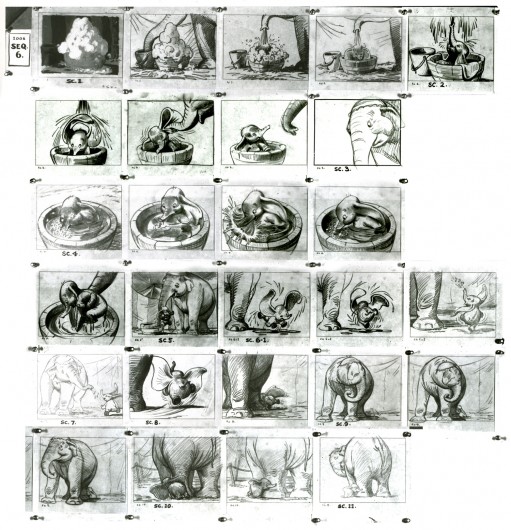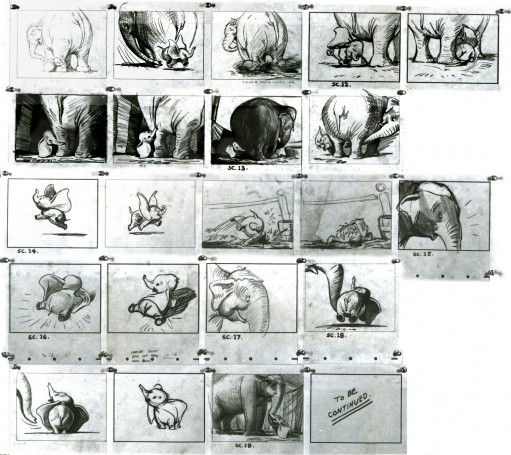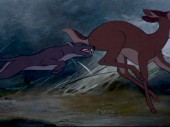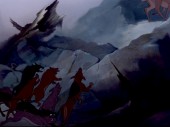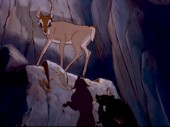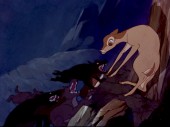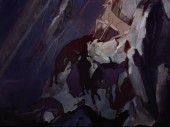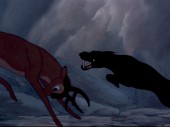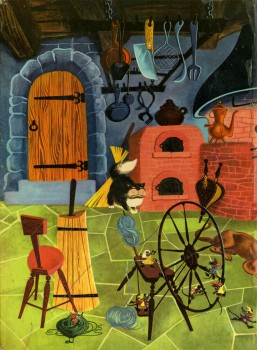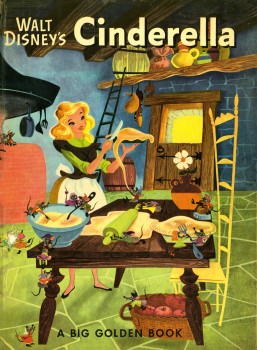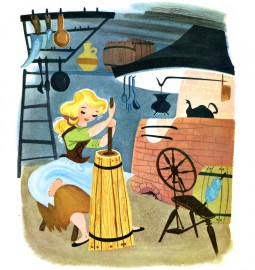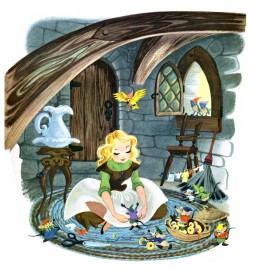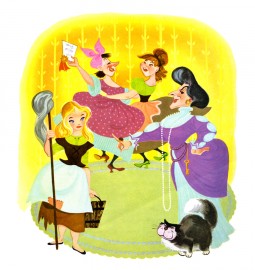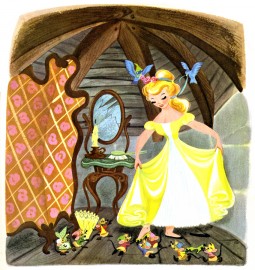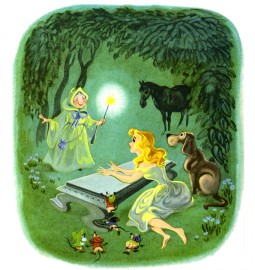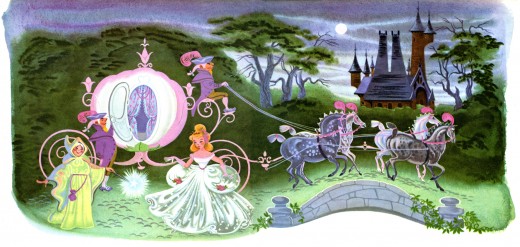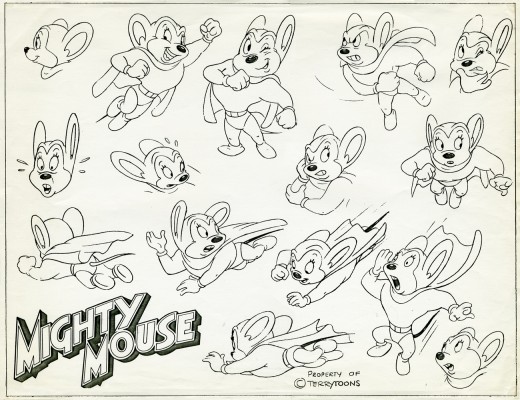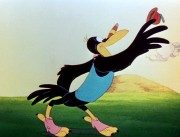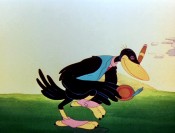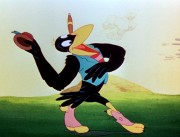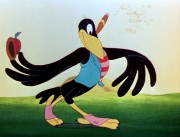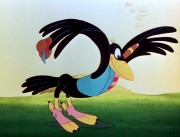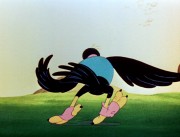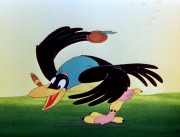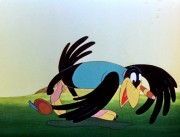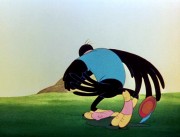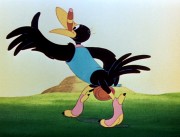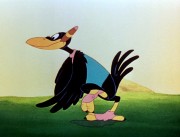Search ResultsFor "dumbo"
Animation Artifacts &Disney &Story & Storyboards 27 Nov 2007 08:48 am
Bill Peet’s Dumbo Board
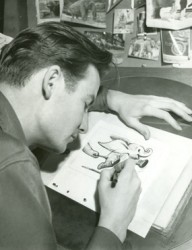 - Thanks to a loan from John Canemaker, I can continue posting some of the brilliant storyboard work of Bill Peet. The guy was a masterful artist. Every panel gives so much inspiration and information to the animators, directors and artists who’ll follow up on his work.
- Thanks to a loan from John Canemaker, I can continue posting some of the brilliant storyboard work of Bill Peet. The guy was a masterful artist. Every panel gives so much inspiration and information to the animators, directors and artists who’ll follow up on his work.
This is the sequence from Dumbo wherein baby Dumbo plays around the feet of his mother. Brilliantly animated by Bill Tytla, this sequence is one of the greatest ever animated. No rotoscoping, no MoCap. Just brilliant artists collaborating with perfect timing, perfect structure, perfect everything. Tytla said he watched his young son at home to learn how to animate Dumbo. Bill Peet told Mike Barrier that he was a big fan of circuses, so he was delighted to be working on this piece. Both used their excitement and enthusiasm to bring something brilliant to the screen, and it stands as a masterpiece of the medium.
Of this sequence and Tytla’s animation, Mike Barrier says in Hollywood Cartoons: What might otherwise be mere cuteness acquires poignance because it is always shaded by a parent’s knowledge of pain and risk. If Dumbo “acted” more, he would almost certainly be a less successful character—”cuter,” probably, in the cookie-cutter manner of so many other animated characters, but far more superficial.
I had to take the one very long photstat and reconfigure it in photoshop so that you could enlarge these frames to see them well. I tried to keep the feel of these drawings pinned to that board in tact.
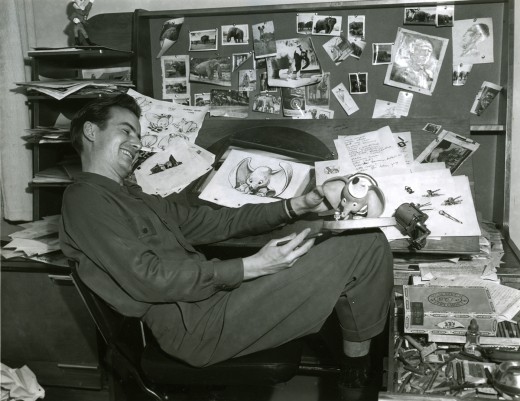
Bill Peet at his desk on Dumbo.
_______________________________________________Tomorrow, Bill Tytla‘s Dumbo.
Photos 01 Jul 2007 08:33 am
Coney Island Photo Sunday
 – Last week, Heidi and I went out to Keystone Park to watch the Mets’ AAA ball team, the Cyclones. This ball park is right next door to Coney Island. We went because Heidi’s group at the New Victory Theater planned the outing, and we had a great time with them. Since the amusement park is about to undergo reconstruction, it seemed like a good time to visit that as well.
– Last week, Heidi and I went out to Keystone Park to watch the Mets’ AAA ball team, the Cyclones. This ball park is right next door to Coney Island. We went because Heidi’s group at the New Victory Theater planned the outing, and we had a great time with them. Since the amusement park is about to undergo reconstruction, it seemed like a good time to visit that as well.
I found some difficulty watching the game – we ended up in right field in the bleachers.
It was impossible to figure out who the players were for the Cyclones, never mind the opposing team, the Renegades. It’s hard to care who wins unless you’re a diehard Met fan, and I’m not. I don’t even like the Mets. As a matter of fact I kept checking into the Yankee loss on the radio during this AAA game.
 2
2  3
3
The field was attractive, and the park seemed small, despite the regulation sized field.
The team played well, winning the game after having to come back from a deficit.
 4
4  5
5
4. The scoreboard was impossible to read during daylight hours, but it was fun with the drawn, cut-out “Cyclone” (a roller coaster in coney island park) at the top.
5. It’s hard to avoid the real “Cyclone” behind the scoreboard toward left field. The siren call of the Wonder Wheel sang to us throughout the game.
 6
6 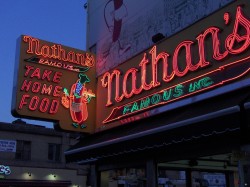 7
7
6 & 7. Nathans, of course, is the gateway to the Coney Island theme park. The place is always crowded, and I assume the food is great.

A little trip down a boardwalk, passing the gaming areas, brings you to Astroland.
This is the part of the park that’s undergoing reconstruction and closings..
 9
9  10
10
9. Walking down that boardwalk, the Wonder Wheel keeps beckoning. This ride is sort of a Ferris Wheel mixed with a Roller Coaster. It’s frightening. As you revolve, the carriages race forward or back as gravity dictates. It looks calm and takes you by surprise.
10. Finally you enter Astroland. It looks like a kiddie park; the ones that Walt Disney was trying to make obsolete. He wanted parents to be able to participate.
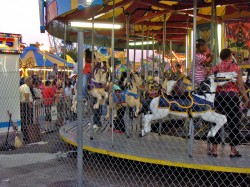 12
12 13
13
12. The carousel gets more and more attractive to me as I get older.
13. The goofy looking haunted house was called Ghost Hole. We were starting to get into their versions of characters.
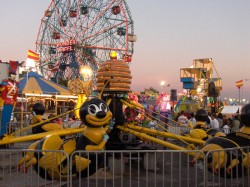 14
14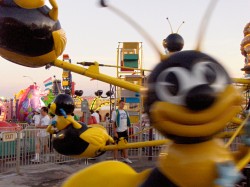 15
15
14 & 15. The famous bumble bee is the first of the characters you come upon. I kept looking for someone walking around dressed like a bee.
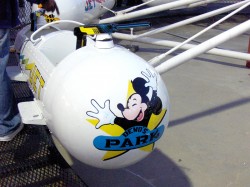 16
16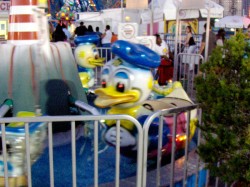 17
17
16 & 17. You know that’s not Mickey or Donald. They’d have to pay a licensing fee.
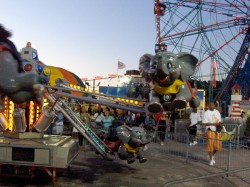 18
18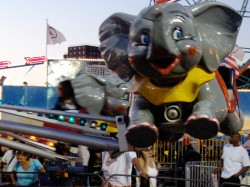 19
19
18 & 19. And that flying elephant is no relation to Dumbo.
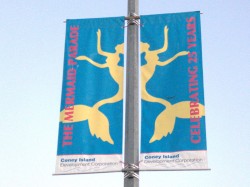 20
20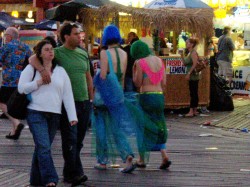 21
21
20. As the sign says, it was also the day of the Mermaid Parade. Lots of people dress as mermaids and parade down the boardwalk. I usually watch a public access TV show in Manhattan that annually broadcasts the entire parade. They play musak in the background and you just watch the crazies flaunting their homemade costumes and eccentric makeup.
21. So all day long we were seeing the fallover from this parade.
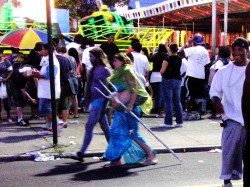 22
22 23
23
22. There were a couple of other mermaid dressed people I photographed but seem to have deleted the pictures. Sorry.
23. Finally, I grabbed my own mermaid, and we went home. I was tired; I’m getting too old for this.
Books &Mary Blair 25 Jun 2007 07:30 am
Retta Scott & Cinderella I
– Retta Scott‘s name was always an intriguing one for me.
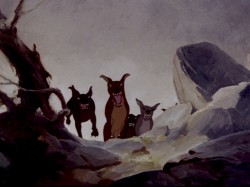 She was an animator on Bambi, Dumbo and Plague Dogs. She was layed off at Disney’s when they hit a slump in 1941 but came back to do a number of Little Golden Books for Disney. The most famous of her books was her version of Cinderella, one which was so successful that it remains in print today as a Little Golden Book.
She was an animator on Bambi, Dumbo and Plague Dogs. She was layed off at Disney’s when they hit a slump in 1941 but came back to do a number of Little Golden Books for Disney. The most famous of her books was her version of Cinderella, one which was so successful that it remains in print today as a Little Golden Book.
When asked why females weren’t animators at the studio, the Nine Old Men who traveled the circuit, back in the 1970′s, often mentioned her. They usually also said that she was one of the most forceful artists at the studio, but her timing always needed some help (meaning from a man.)
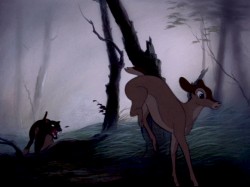 Ms. Scott was known predominantly for her animation in Bambi. Specifically, she’s credited with the sequence where the hunter’s dogs chase Faline to the cliff wall and Bambi is forced to fight them off.
Ms. Scott was known predominantly for her animation in Bambi. Specifically, she’s credited with the sequence where the hunter’s dogs chase Faline to the cliff wall and Bambi is forced to fight them off.
The scene is beautifully staged and, indeed, is forceful in its violent, yet smooth, movement. I was a young student of animation, so this sequence had a long and lasting impression on me.
.
Here are some of her illustrations for Cinderella published in 1950 to tie in with the Disney film. Oddly, the illustrations don’t completely look like the film’s characters. The cat and mice are close, but Cinderella, herself, is very different, less realistic. She looks more like a Mary Blair creation. When I was young, I was convinced that these were preproduction illustrations done for the film. If only.
To do justice to this book, though I’m not posting ALL of the illustrations, I’ll break it into two postings.
Books 12 Jun 2007 08:00 am
Tony Goes Flying
- Tony Eastman is one of New York’s animation jewels. He’s been an animator/director for as long as I can remember. He’s produced animation films and animated for others. He’s aslo worked with me on a couple of projects; he’s quite a talent with a sensitive style and a smile in his work.
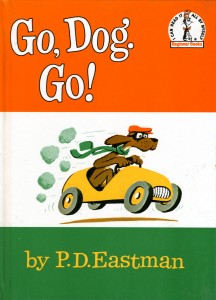 Tony is the son of Phil Eastman. We animation people know him as the co-author with John Hubley of Brotherhood of Man, one of the films that started UPA. To quote the introduction to the published script:
Tony is the son of Phil Eastman. We animation people know him as the co-author with John Hubley of Brotherhood of Man, one of the films that started UPA. To quote the introduction to the published script:
- THE SCRIPT of Brotherhood of Man and the illustrations from that animated cartoon are essentially an end product of a pamphlet called Races of Mankind which was written in 1943 by Drs. Ruth Benedict and Gene Weltfish, anthropologists of Columbia University. It was designed for presentation to men of the armed forces as an antidote to racial prejudice. This film has been made by United Film Productions at the instance of the UAW-CIO.
However, Phil Eastman as P.D. Eastman is known to the rest of the world as the genius behind all those early-reader books for young kids which were published by Random House.
Likewise, Tony Eastman is following in his father’s footseps using the name
Peter Eastman for the children’s books he is authoring. 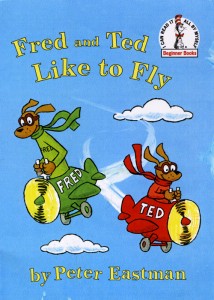
This is to celebrate his newest book which just hit the market: Fred and Ted Like To Fly, the follow up to his successful book, Fred and Ted Go Camping.
Beginner books are particularly difficult to do in that the vocabularly is more limited, the stories are simpler, and it takes enormous creativity to keep them smart and sharp. I very much like the twists that Peter “Tony” Eastman has taken to the form and feel that he has taken the scepter left behind by his father, and brought it to new heights.
It looks like Dr. Seuss, who is probably more popular than even in his lifetime, has some serious competition. Are these characters going to transfer to animation anytime soon?
Congratulations to Tony. He deserves some great success with these new children’s classics he’s writing.
- Speaking of books, I’ve always enjoyed it when authors review other authors’ works. Give me John Updike reviewing any book in the New Yorker, and I’m ready to fly. When animators write books there’s often something special going on. Recently, I’ve read two such reviews of Mike Barrier’s new book, The Animated Man: A life of Walt Disney.
John Canemaker has an interesting review about to be published in Print Magazine. It’s quite astute and an in depth evaluation. It’s only available in print editions, so look for it to hit the newsstands soon.
David Levy, ASIFA East‘s President has a column in the new newsletter sent out to members. This hasn’t yet appeared on the ASIFA East website (I’m sure it will soon.) However, David gave me permission to post it here. Since I think he has some intelligent comments to make I’m pleased to showcase it.
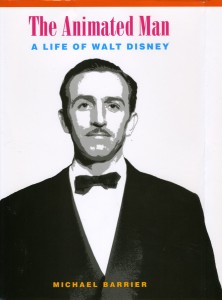 A life of Walt Disney by David Levy
A life of Walt Disney by David Levy
- I’ve read a handful of biographies on Walt Disney over the years, and I can say with certainty that Michael Barrier‘s new book, The Animated Man: A life of Walt Disney (University of California Press) is the very best. Although the book is laden with quotes pulled from interviews with those who knew and worked with Walt, the anchor of the book is Barrier’s research based conclusions. The author pulls much of his best information from official documented studio notes taken from meetings that demonstrate Disney’s role in shaping his studio’s art.
Here are just some of the book’s many revelations that just about blew me away.
1. The reality that Oswald The Lucky Rabbit, Disney’s pre-Mickey character series, was not a project born of inspiration. In fact, Universal ordered the series by description, asking for a rabbit character named Oswald the Lucky Rabbit. As Barrier tells it, Disney arrived back at his studio with the news that his crew would be switching production from Alice to Oswald. It reminded me of a factory switching product manufacturing based on a new order, which in essense, is what it was.
2. The idea that departure of Ub Iwerks from Disney was actually a plus and a necessary incident in the development of animation at the Disney studio.
3. The fact that little or nothing in Disney’s early pre-Mickey Mouse’s history shows any evidence that he would become the artist/industry leader that he became. Disney’s early works are as crude and filled with short cuts as any other silent era animation producer.
4. Disney features from Cinderella onwards were no longer pre-scored beyond song sequences. For exam ple, in an early feature such as Pinocchio, the music that accompanied Jiminy Cricket’s dash across the street would be pre scored, in other words, written and recorded before any animation was done.
The story artist, sequence director, and lead animator would work with the track and the resulting animation was connected to the sound track in a ay that could not be achieved by post scoring the animation. Scoring a film after the picture is complete is the way live action films are made and that is one of the reasons why all the Disney features from Cinderella through Jungle Book are a far less rich experience.
5. The suggestion that the two Disney feature films that assigned animators to characters the way actors are cast as characters were all
the more better because of it. For evidence, seek out Fred Moore‘s seven dwarf animation and Bill Tytla‘s animation of Dumbo and his mother.
6. The way Barrier connects how Disney’s passions for trains and miniatures paved the way towards his creation of Disneyland. Talk about productive hobbies! Finally, a key theme of the book is that the animation breakthroughs leading up to and including Snow White and the Seven Dwarfs did not really lead the Disney artists beyond that. In a form of arrested development, key animation innovators such as Tytla, Babbit, Ferguson, and Moore, were all replaced by younger higher-quality draftsman, Nine of which, would become the fabled “Nine old men”. While the draftsmanship improved under the Nine old men, a life-sucking literalness also crept into the animation. Each of us can decide for themselves if what was gained was worth more than what was lost. But, of course, nothing is really ever lost, just possibly a sleep for a while (Just like Snow White, herself). Pick up this book today! It’s your summer read.
And, if you just can’t get enough Michael Barrier, check out his great Web site: www.michaelbarrier.com. I also highly recommend his terrific commentaries on the four Warner Brothers cartoon DVD collections.
Personally, I’m just about creeping up to the end of the book. As soon as I do, I’ll give some comments of my own which certainly won’t be as observant or as articulate. Thanks to David Levy for allowing me to reprint this. It should also appear on the ASIFA East site soon.
Daily post 26 May 2007 08:23 am
Cannes & PosterArt
Two animated films are among the shorts in competition at Cannes. These are:
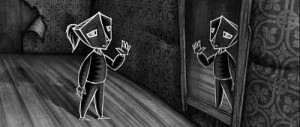 Spegelbarn (Looking Glass) is from Sweden/Finland/Denmark.
Spegelbarn (Looking Glass) is from Sweden/Finland/Denmark.
Swedish filmmaker, Erik Rosenlund is the Director/producer/animator
The synopsis reads: A dark stormy night. A little girl is home alone, but is she really?
The second film is
 Ark from Poland.
Ark from Poland.
Grzegorz Jonkajtys is the Polish Director of the film.
Synopsis: An unknown virus has destroyed almost the entire human population. Oblivious to the true nature of the disease, the only remaining survivors escape to the sea. In great ships, they set off in search of uninhabited land. So begins the exodus, led by one man. . .
Neither of these films is listed among those to be screened at Annecy.
The award ceremony at Cannes will be held tomorrow, Sunday.
Through Aug. 1, the Posteritati Movie Poster Gallery (239 Centre St.) lets New Yorkers escape into the past with a collection of art from fantasy films ranging from 1937′s “Snow White and the Seven Dwarfs” to modern-day favorites like “Raiders of the Lost Ark” and “The Incredibles.”
Gallery hours are Tuesday – Saturday, 11 a.m. to 7 p.m.; Sundays, noon to 6 p.m.
….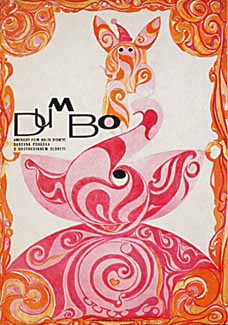 ….
….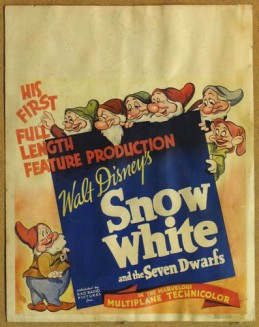
The 1960 Czech poster (above left) for Dumbo (1941) and the original US poster (above right) for Snow White (1937).
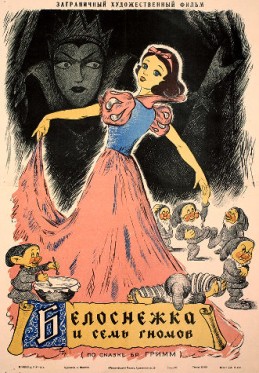
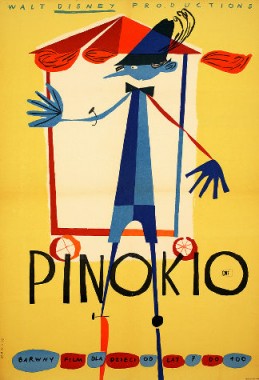
>A 1955 Russian poster (above left) for Disney’s ‘Snow White and the Seven Dwarfs’ (1937), the first animated feature released in the U.S. and a 1962 Polish poster (above right) for Disney’s ‘Pinocchio’ (1940).
Commentary 04 May 2007 08:01 am
Brando-style Acting Animated
(Note: I wrote this piece based on Mark Mayerson’s initial comments about acting, and I’m responding to what I read there. He has expounded on those thoughts, and I should react. But I think I’ll let this post sit as it is.)
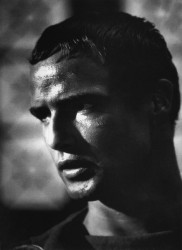 – Mark Mayerson, on his blog, offered enormous and deserved praise for Marlon Brando‘s acting. He then compared it to animation suggesting that no animator has touched the surface of Brando’s work (my phrasing – not Mark’s). This commentary had me mulling about anima-tion and animation acting for the next day or so, and I thought I should comment.
– Mark Mayerson, on his blog, offered enormous and deserved praise for Marlon Brando‘s acting. He then compared it to animation suggesting that no animator has touched the surface of Brando’s work (my phrasing – not Mark’s). This commentary had me mulling about anima-tion and animation acting for the next day or so, and I thought I should comment.
Since I’m prone to ramble, I decided not to overwork Mark’s site with my words and to post it here. Consequently, I think that you might want to read Mark’s not-very-long commentary if you want to continue; go here.
To start with, Mark ends his piece by suggesting that Gollum, the character, is probably the closest that animation has to Brando. This I have to push away from my table with one big stroke.
I don’t understand how a character could be the equivalent of Brando. Even if I thought Gollum were well animated (and I don’t even consider it animation – the way I consider Tytla’s work animation), I would have to compare it to one of Brando’s characters – Stanley, in Streetcar, perhaps.
Perhaps I misunderstand Mark’s thought here.
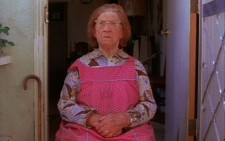 Years ago I was exiting the premiere of Errol Morris‘ first documentary feature, Gates of Heaven. I was shaken, disturbed and said so to my companion. The documentary was an anti-New Wave film. Yet, animation hadn’t even had its own New Wave! (And still hasn’t!) What hope was there for my chosen field?
Years ago I was exiting the premiere of Errol Morris‘ first documentary feature, Gates of Heaven. I was shaken, disturbed and said so to my companion. The documentary was an anti-New Wave film. Yet, animation hadn’t even had its own New Wave! (And still hasn’t!) What hope was there for my chosen field?
Intelligently, my companion reminded me of Yurij Norstein‘s masterpiece, Tale of Tales. I knew she was right; Norstein had pushed animation up to the equal of live action. The future was as much in my hands as documentaries were in Errol Morris‘ hands.
How many times since then have I reminded myself of Tale of Tales?
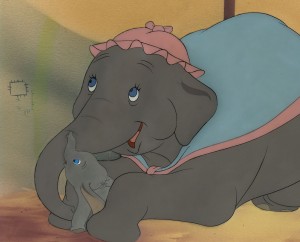 I do think there are animators who were the equivalent of Brando.
I do think there are animators who were the equivalent of Brando.
Tytla was certainly one. I think Tissa David‘s work is on a par with Brando (though I usually think of her closer to Meryl Streep – to me every bit the equal to Brando. (The divine moment in the mediocre film, Devil Wears Prada, where Streep sits in a bathrobe, with bare feet, allowing her vulnerability to escape, before hardening again, has to have been the finest acted moment in film last year.)
The fact that a handful of animators with the knowledge of their craft and the ability to use it didn’t get the work or the part is, to me, irrelevant. If Brando had only played the equivalent of Superman’s father for his entire career, we wouldn’t be talking about him. But he did play that role as well as other mediocre parts, and he played them all extremely well. He also played many masterful roles throughout his career. He gave actors a point in the sky to which they could stretch.
Tytla – there can be no doubt – was in the stratosphere. He is the one we all point to. Stromboli in Pinocchio, Chernobog in Fantasia, Dumbo under his mother’s legs, the dwarfs in Snow White. Can there be any greater acting? The fact that he was forced out of Disney’s studio to the lacking resources of Terrytoons had to affect everything he did. There was no possibility of his continuing the brilliant work. He was subjected to be Superman’s father for the rest of his career.
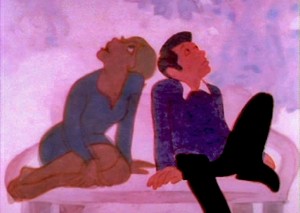 Tissa David is an animator who has made a career of the little human touches among those brilliantly drawn characters of hers. She has worked always on a very tight budget with high footage rates. She has had projects the equivalent of some of those Tytla Disney films, but she was always forced to the ground with their Independent budgets. She has had a couple of large budget projects that had poor stories and/or characters that she had to develop. The fact that she has not always had the great budgets to support her great characters has not hurt her work. She is still a great actress, and her characters – even on three’s – live. Unfortunately, most of her work has been done in the regional theater of animation where the audiences aren’t massive. However, she has made gold of what was handed her, and her talent and abilities are every bit the equal of Brando – and Streep.
Tissa David is an animator who has made a career of the little human touches among those brilliantly drawn characters of hers. She has worked always on a very tight budget with high footage rates. She has had projects the equivalent of some of those Tytla Disney films, but she was always forced to the ground with their Independent budgets. She has had a couple of large budget projects that had poor stories and/or characters that she had to develop. The fact that she has not always had the great budgets to support her great characters has not hurt her work. She is still a great actress, and her characters – even on three’s – live. Unfortunately, most of her work has been done in the regional theater of animation where the audiences aren’t massive. However, she has made gold of what was handed her, and her talent and abilities are every bit the equal of Brando – and Streep.
And there is Tale of Tales. Norstein has done it many times from that truly adult film, to Hedgehog in the Fog or The Heron and The Crane. The direction is brilliant, the filmmaking superb, and the acting equal to the greatest. The unfortunate part is that he has done so little work since the fall of the USSR. (Check out the beautiful and recent Winter Days.)
Brando’s acting style came out of the Actors’ Studio which was an outgrowth of the Group Theater which grew out of Stanislavsky. I always like to think back on a comment John Hubley told me. He said that a small number of those at the Disney were ardent advocates of Stanislavsky, but the rest of the studio couldn’t spell it. Tytla was definitely one of the advocates; just take a look at Chernobog and try to argue otherwise. Tissa came out of France at just the time that the French New Wave started to spark. She went to work under the wing of Grim Natwick who was also one of the Stanislavsky devotees.
Mark is right that there are very few people who could be tagged with such greatness. Most of those I can think of are dead or are no longer working.
These days acting techniques and stylization has grown so enormously sophisticated. Animation abilities have gone in the opposite direction. Today, in animation, it’s all about the broad gesture. I don’t think there is anyone among the young stretching – or trying to stretch – to the same heights, and I’m not sure there will be any more. Though I can hope
- By the way, you should already know that Mark Mayerson has been posting enormously 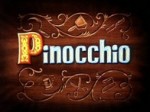 valuable information with his breakdowns and analysis of Pinocchio, scene for scene.
valuable information with his breakdowns and analysis of Pinocchio, scene for scene.
It would be wonderful if somehow Mark got this bound in a published volume. He’s just posted the seventh part of his notes on the “Mosaics” he’s been doing of this monumental film. If you have any interest in animation, you should be following these posts.
Animation Artifacts &Commentary 20 Mar 2007 07:33 am
Kimball
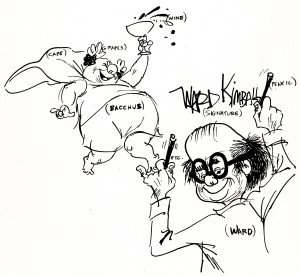 – I notice that there were a number of sites today featuring articles and material about Ward Kimball, (e.g. here and here) and there’s the Ward Kimball/My Space page which I visited. Jaime Weinman has a post that presents thoughts which I certainly agree with. In fact, they could have been mine.
– I notice that there were a number of sites today featuring articles and material about Ward Kimball, (e.g. here and here) and there’s the Ward Kimball/My Space page which I visited. Jaime Weinman has a post that presents thoughts which I certainly agree with. In fact, they could have been mine.
A year ago, I posted a couple of Kimball drawings. These came to me years ago (the 70′s?) via John Canemaker. The Bacchus drawing appeared in his Nine Old Men book. I have a few more drawings by Ward Kimball, and I thought it’d be nice to post a few of them.
I’ve always had mixed feelings about Kimball’s work. On the one hand his persona as presented to the public was always annoying. He came off as the wacky cartoonist who just wanted to show you how wacky he was. (There was a hint of this in Chuck Jones, as well.) He obviously had a big ego and had good reason for it. There was no doubt that this guy could draw like a son-of-a-gun, and his animation was often breathtaking. It always sided more toward the cartoon rather than the real, and it had a style so different from the others. You had to admire it.
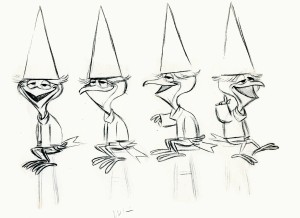 The crow sequence in Dumbo is brilliant, to say the least; the Mad Hatter in Alice is the heart of that film (though I wish it weren’t), and the Cheshire cat the most memorable part; and Toot Whistle Plunk & Boom is probably the best short done at Disney’s after WWII. However, there’s nothing I liked about the Oscar winning It’s Tough To Be Bird or Dad Can I Borrow The Car?. (This is a good example of Kimball’s personality entering the films.)
The crow sequence in Dumbo is brilliant, to say the least; the Mad Hatter in Alice is the heart of that film (though I wish it weren’t), and the Cheshire cat the most memorable part; and Toot Whistle Plunk & Boom is probably the best short done at Disney’s after WWII. However, there’s nothing I liked about the Oscar winning It’s Tough To Be Bird or Dad Can I Borrow The Car?. (This is a good example of Kimball’s personality entering the films.)
(Click any image to enlarge.)
.
The interview Mike Barrier did with Kimball in 1969-1986 offers some good insight into the man and some excellent detail. It adds to the piece Canemaker wrote in The Nine Old Men. Many people have written about Kimball, but I think John Canemaker‘s book has to cover his career best. It brings him to life and gives us a good encapsulation of his life and work.
.
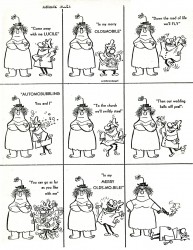
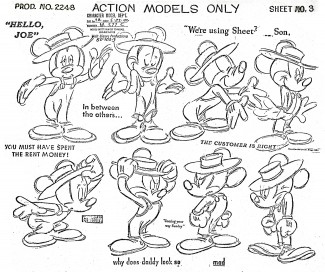
The comic to the left is obviously and ad parody, but don’t ask me what this Mickey compilation model sheet is. What’s with all the type?
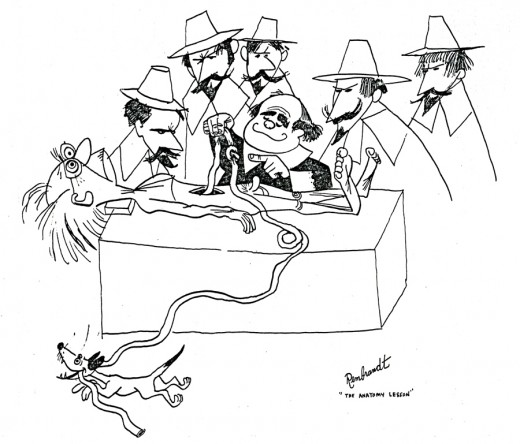
This was obviously a card for someone (Oliver Wallace?) who was operated on. I’m sure I’d have enjoyed something this funny if I was trying to recuperate.
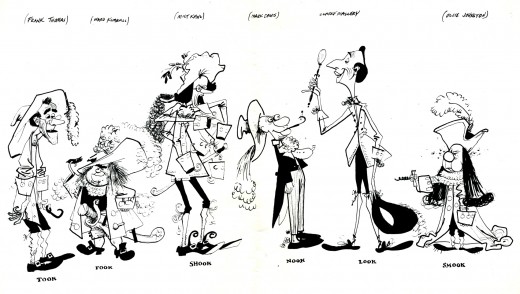
This caricature tells you that there must have been some real competition among the animators as the Captain Hook character approached.
You can watch some Kimball clips on YouTube (until someone takes them down.)
Disney Family Album Opening and Part 1 and Part 2.
Escalation, an independent anti-war (Viet Nam) short
the Snow White soup eating scene P.T.
Thad Komorowski has posted quite a few clips from Kimball. Here are some:
Cinderella‘s Lucifer
Dumbo‘s crows
Mother Goose Goes Hollywood 1, 2, 3
The Three Caballeros
Animation Artifacts &Models &UPA 20 Feb 2007 08:04 am
Random Models
- Did I ever mention that I was a model-sheet Junky? I love them, no matter where they come from or how big they are. I enjoy looking at notes on them, how they were constructed, and signatures. The whole package.
They come in so many sizes, forms and designs.
This is why I get off on a couple of sites that post some beauties. The ASIFA Hollywood Animation Archive has done this frequently, e.g here, here and here.
The Disney Informer also offers quite a few models.
Here are a few from from my collection representing different studios. Of course, I’ll start with Disney, the classics:
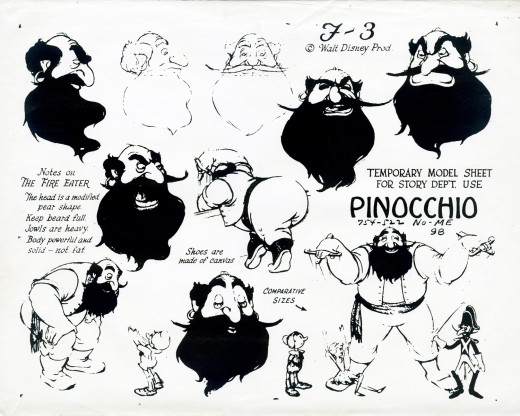
The three models I have are matte photostats, though I believe the handouts were copied onto Disney’s large 5-hole animation paper. On one of these you can see traces of the pegholes.
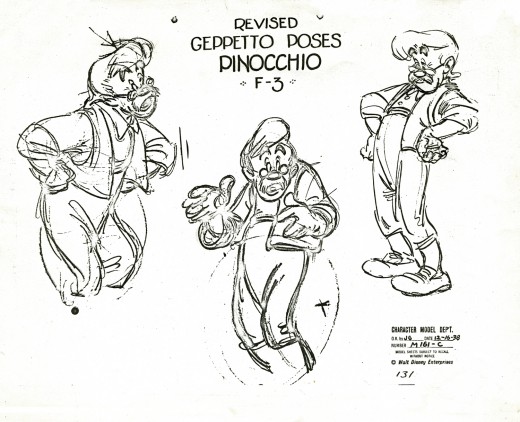
I have a large cel of Gepetto from the pose on the left, hands akimbo. I’m not sure it was ever in the film.
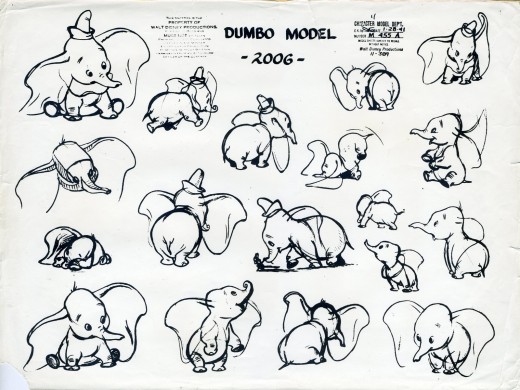
What a beautiful Dumbo. I think I could look at these drawings all day. It’s one of my favorite films. No tricks, no pretensions. Just a great cartoon to make you cry. This is the top of their game.
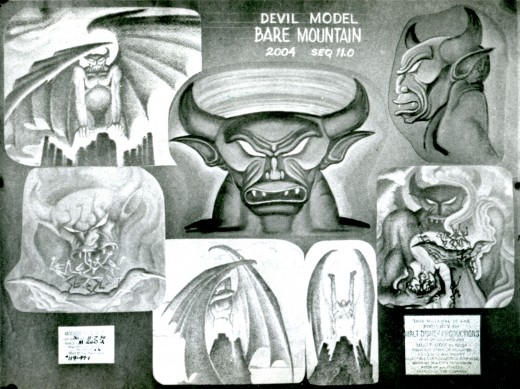
Unfortunately, this one is a photograph I have of the model on a bulletin board. It’s not the best focus.
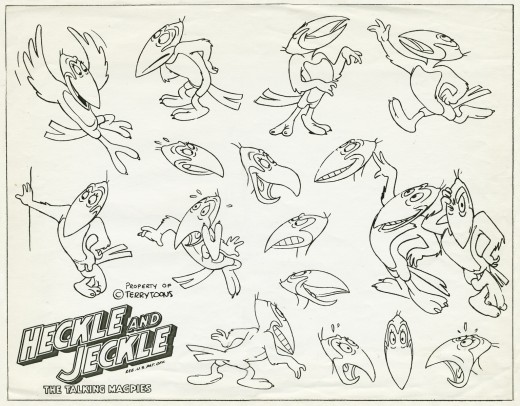
Terrytoons had a beautifully composed model sheet with some fine poses. I wonder how much this helped Jim Tyer. Another Terry model sheet, one of Mighty Mouse, follows. I suspect that Connie Rasinski drew both of them.
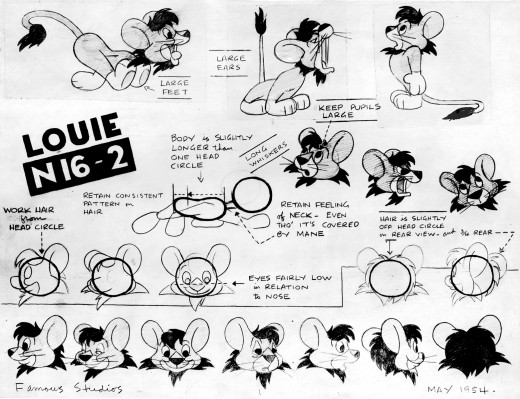
At Paramount, they were a little different. The stats they made, at least those I have, were high gloss. This one has some damage to it where it must’ve gotten wet.
This is the info for this short I found on Dave Mackey‘s invaluable site: Lion In The Roar Rel 12/21/56 – Noveltoon Featuring Louis The Lion, Directed by Seymour Kneitel. Larry Riley drew this model.
I have a couple of the original models which were compiled on animation paper from cut-out drawings. The glue has had a hard time holding up. I gave examples of this last year with an Indian film. See here and here.
The animators received these glossy stats.
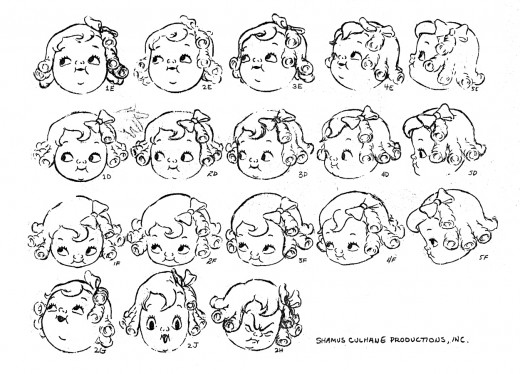
For this Campbell Soup commercial a lot of effort went into drawing the girl. No doubt they were out to please a client. This is the best this character has ever looked.
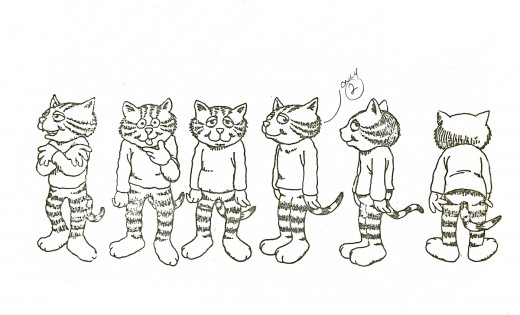
By the time we get to Fritz the Cat, the Xerox machine was in use to make hand-outs for the staff. They didn’t bother with photostats.
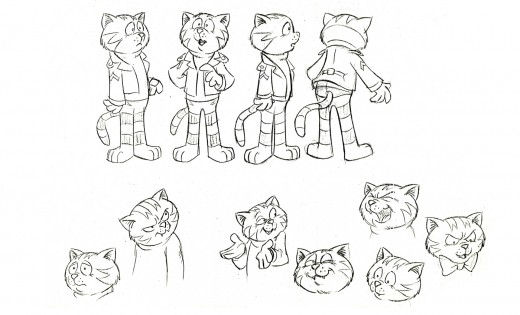
The drawings look like different artists were at work. No wonder the character shifts about on screen. I actually enjoy watching that shift. There’s something alive about it.
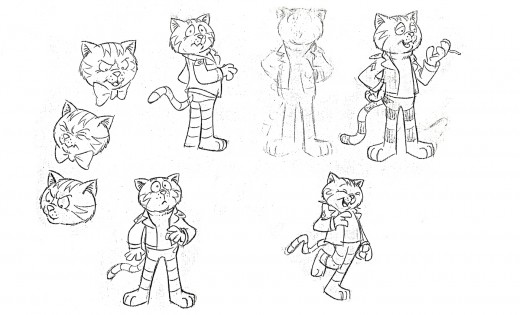
I keep thinking these last two are from The Nine Lives of Fritz the Cat, but I’m sure they came from the original film.
- May I suggest you go to a couple of other sites today, while they’re still fresh. Good work from both of these regular must-read writers.
- Floyd Norman‘s essay over at Jim Hill Media is as great a read to me as anything else he’s written, and I love reading all of his pieces.
- Mark Mayerson has a great piece on his site today whcih certainly got me weathered up. He definitely has some of the most thoughtful, provocative and interesting material on the web.
Commentary &Daily post 31 Dec 2006 09:26 am
Out With The Old
- I can’t find a better thing to say than Oscar Grillo has posted on his site. A brilliant drawing set against a brilliant soundtrack, with words to match. Go.
- Taking a quick tour of a lot of sites this morning, I found that the griping about promotion for animators is high on the list on a number of blogs. It all started with George Miller‘s insensitive comments in the New York Times about his animation staff. Miller got a bit of promotion in the Times article on dancer/choreographer, Savion Glover. He was trying to help Glover and a lot of animators got slapped as a result.
Mark Mayerson suggests that animators need more promotion for themselves to counteract some of this public image. Keith Lango follows this with other thoughtful comments agreeing with Mark. Of course, the problem starts entering when a number of the comments on these blogs react by swiping at Miller in an even less sensitive display. They respect him, even less that he respects animators.
I don’t think Miller, like any good director, thinks any less of his animation crew than he does his electrical crew. He believes that they are all in service to him. And they are. At least, this is true using Motion Capture.The “animators” are no longer the actors. They’re technical service personnel. Special Effects wizards with computers who transfer the dances of Savion Glover into penguins dancing. The delicate movements of the characters perfectly capture the motions of Glover so that it looks like Glover dancing.
(Actually, I’ve seen Glover on stage and in film so many times, that I’d probably prefer seeing him dancing rather than 100 versions of him as a penguin dancing.)
I enjoyed watching the film Happy Feet, but probably won’t see it again. Yet, I’ve watched Dumbo at least 100 times. Just yesterday I watched Ward Kimball‘s dance sequence from that film. I have no doubt it was choreographed, shot on film for him to study and, finally, animated by him. All those drawings cannot be captured by the MoCap technology. I think that’s the message we have to talk about in 2007.
Until we take back the creating part of these films, we can’t blame others for taking and handing out credit.
Animation Artifacts &Daily post 27 Dec 2006 08:38 am
Tytla and the Best
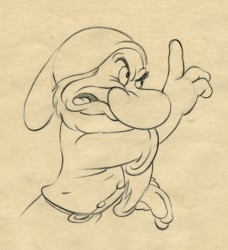 – In 1994 John Canemaker organized an exhibit for the Katonah Museum of Art. It showcased in great detail the work of animation’s, Bill Tytla. The Hollywood Animation Archive Blog now posts the catalog for that show in the first of two parts.
– In 1994 John Canemaker organized an exhibit for the Katonah Museum of Art. It showcased in great detail the work of animation’s, Bill Tytla. The Hollywood Animation Archive Blog now posts the catalog for that show in the first of two parts.
I remember the show as quite remarkable. Any enormous respect I had had for Bill Tytla’s work was magnified exponetially.
Viewing the catalog again reminds me of the fabulous work that John Canemaker had done in organizing the show. Thanks, yet again, to the work of Stephen Worth in making this available at the site.
A Tytla drawing from my collection.
(click on image to enlarge.)
- This list of the Best Children’s films of 2006 includes my film, The Man Who Walked Between The Towers, and the feature Monster House as the only two animated films on their list of “bests.”
To show how ridiculous this list from Scripps Howard News Service is, the new dvd of Dumbo is on their “worst” of 2006 list. They describe one of my favorite Disney features as, “a relic, with a number of racist and stereotyped characters and overwrought emotion.”
The scene Tytla animated of Dumbo playing in the legs of his mother is, in my opinion, one of the best scenes ever animated. Every child should be made to watch this scene and this film. John Canemaker’s commentary for the dvd is, as I’ve said several times on this blog, one of my favorites. It’s the premiere example, to me, of what all commentary tracks should be.
- For those who haven’t yet seen it, David Nethery has posted on his site a 1966 Christmas Bumper R.O. Blechman did for CBS. It’s a beautiful, music card of a piece that shows all the poetry Blechman got into his films. Ed Smith animated this rich, short film.
- Finally, today, I’d like to quote a paragraph from Michael Musto‘s lookback-at-2006 column in today’s Village Voice. He reviews most of the animated features, and I thought it amusing:
-
We pause now for a brief rant: Much as I adore animated films, the plethora of them
that came out this year with inspiring messages about how critters (or vehicles) are
good and people are bad made me feel their ka-chinging creators should be forced
to live by their own patronizing idealism or die. Cars should have been dumped onto
DVD with no hoopla whatsoever (it’s more important to be a good soul than to
succeed, remember?); the Ant Bully people should find their houses infested with
bugs and then be made to join them to learn the importance of community; and the
Barnyard bunch, who preached that responsibility is superior to having a messy good time, should never be allowed to make another movie. Otherwise we’re destroying
our children with hypocrisy and lies!
But how dare anyone suggest that: Happy Feet ripped off March of the Penguins:
It ripped off Billy Elliot!
